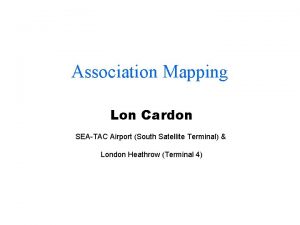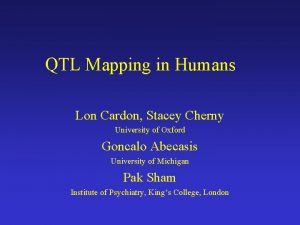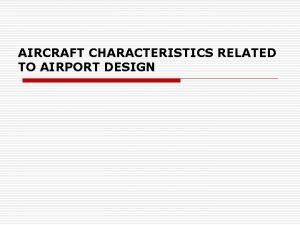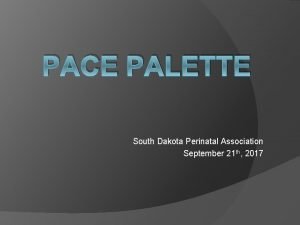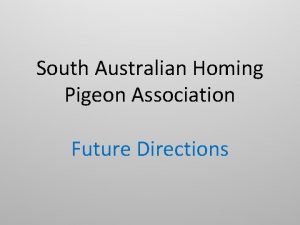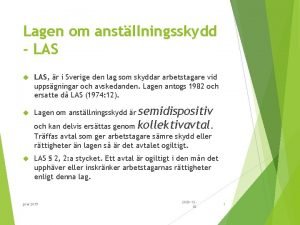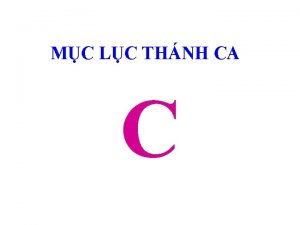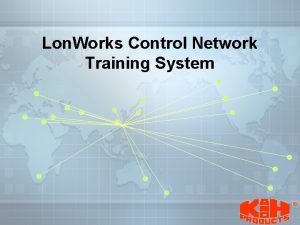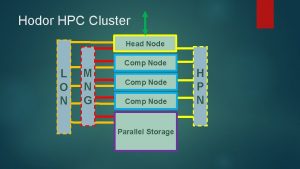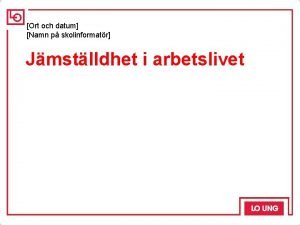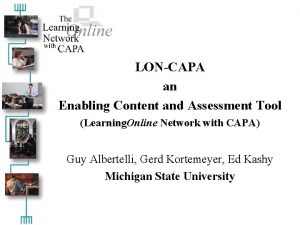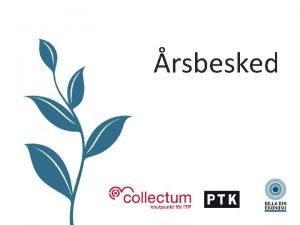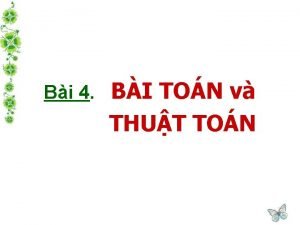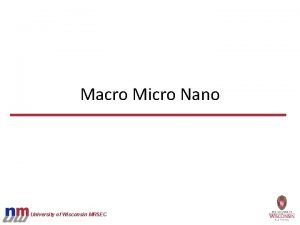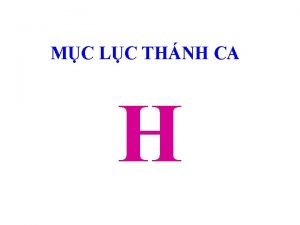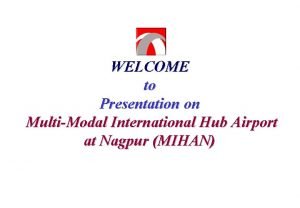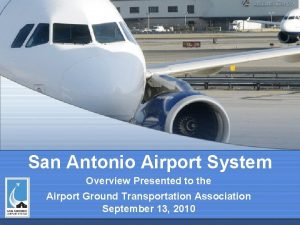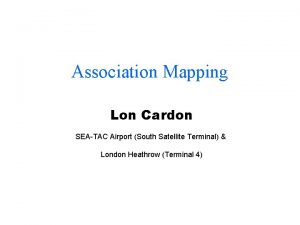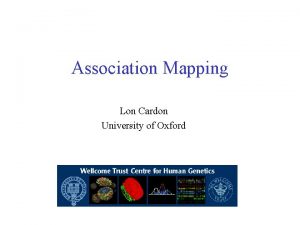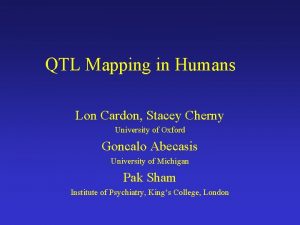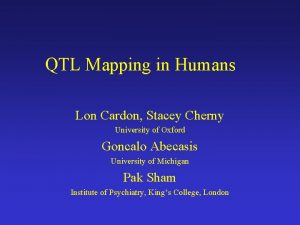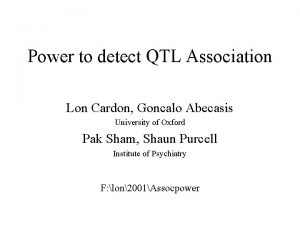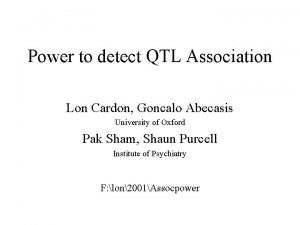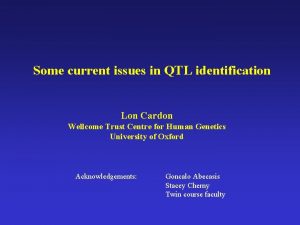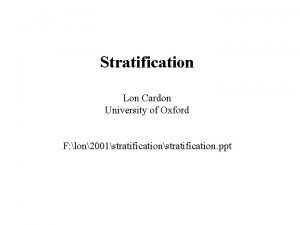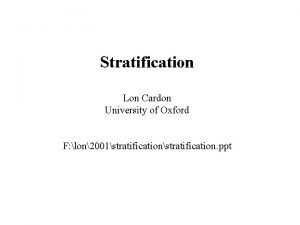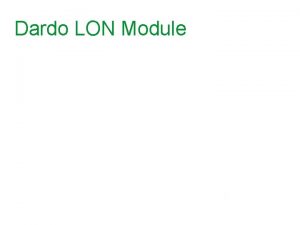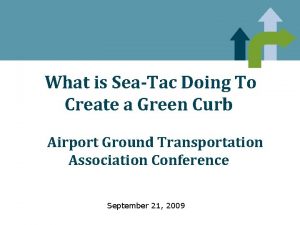Association Mapping Lon Cardon SEATAC Airport South Satellite


















































- Slides: 50

Association Mapping Lon Cardon SEA-TAC Airport (South Satellite Terminal) & London Heathrow (Terminal 4)

Outline • Linkage vs association • Hap. Map/SNP discovery enable whole genome association • Challenges facing whole genome association • Outlook for future

Whole Genome Association Scan Entire Genome - 100, 000 s SNPs Identify local regions of interest, examine genes, SNP density gegulatory regions, etc Replicate the finding * * ** *

Definitions SNPs trait variant chromosome Population Data haplotypes Affection Trait 1…Traitn A 10. 3 75. 66 A 9. 9 -99 U 15. 8 101. 22 genotypes alleles

Allelic Association SNPs trait variant chromosome Genetic variation yields phenotypic variation More copies of ‘B’ allele More copies of ‘b’ allele

Simplest Regression Model of Association Yi = a + b. Xi + ei where Yi = Xi = trait value for individual i 1 if allele individual i has allele ‘A’ 0 otherwise i. e. , test of mean differences between ‘A’ and ‘not-A’ individuals

Association Study Designs and Statistical Methods • Designs – Family-based • Trio (TDT), twins/sib-pairs/extended families (QTDT) – Case-control • Collections of individuals with disease, matched with sample w/o disease • Some ‘case only’ designs • Statistical Methods – Wide range: from t-test to evolutionary model-based MCMC – Principle always same: correlate phenotypic and genotypic variability

Linkage: Allelic association WITHIN FAMILIES affected 3/5 2/6 unaffected 3/2 5/2 Allele coded by CA copies 2 = CACA 6 = CACACA 4/3 Disease linked to ‘ 5’ allele in dominant inheritance 3/5 3/2 4/5

Allelic Association: Extension of linkage to the population 3/5 3/6 2/6 5/6 3/5 3/2 2/6 5/2 Both families are ‘linked’ with the marker, but a different allele is involved

Association AND Linkage 3/5 3/6 2/6 5/6 3/2 2/4 6/2 4/6 6/6 All families are ‘linked’ with the marker Allele 6 is ‘associated’ with disease 2/6 6/6

Allelic Association Controls Cases 6/6 6/2 3/5 3/4 3/6 2/4 3/2 5/6 3/6 4/6 6/6 2/6 5/2 Allele 6 is ‘associated’ with disease 2/6

Power of Linkage vs Association • Association generally has greater power than linkage – Linkage based on variances/covariances – Association based on means – See power lectures in this course

First (unequivocal) positional cloning of a complex disease gene

Inflammatory Bowel Disease Genome Screen Satsangi et al, Nat Genet 1996

Inflammatory Bowel Disease Genome Screen

NOD 2 Association Results Stronger than Linkage Evidence • Analysis strategy: same families, same individuals as linkage, but now know mutations. Were the effects there all along? • TDT • Case-control Genotype Rel Risk = 58. 9, p < 10 -8 Same CD cases vs 229 controls

Localization • Linkage analysis yields broad chromosome regions harbouring many genes – Resolution comes from recombination events (meioses) in families assessed – ‘Good’ in terms of needing few markers, ‘poor’ in terms of finding specific variants involved • Association analysis yields fine-scale resolution of genetic variants – Resolution comes from ancestral recombination events – ‘Good’ in terms of finding specific variants, ‘poor’ in terms of needing many markers

Linkage vs Association Linkage Association 1. Family-based 1. Families or unrelateds 2. Matching/ethnicity generally unimportant Few markers for genome coverage (300 -400 STRs) Can be weak design 2. Matching/ethnicity crucial 3. Many markers req for genome coverage (105 – 106 SNPs) Powerful design Good for initial detection; poor fine-mapping Powerful for rare variants 5. 3. 4. 5. 6. 4. 6. Ok for initial detection; good for fine-mapping Powerful for common variants; rare variants generally impossible

Allelic Association Three Common Forms • Direct Association • Mutant or ‘susceptible’ polymorphism • Allele of interest is itself involved in phenotype • Indirect Association • Allele itself is not involved, but a nearby correlated marker changes phenotype • Spurious association • Apparent association not related to genetic aetiology (most common outcome…)

Indirect and Direct Allelic Association Direct Association D Indirect Association & LD M 1 M 2 D Mn * Measure disease relevance (*) directly, ignoring correlated markers nearby Assess trait effects on D via correlated markers (Mi) rather than susceptibility/etiologic variants. Semantic distinction between Linkage Disequilibrium: correlation between (any) markers in population Allelic Association: correlation between marker allele and trait

Linkage Disequilibrium & Allelic Association Marker 1 2 3 D n LD Markers close together on chromosomes are often transmitted together, yielding a non-zero correlation between the alleles. This is linkage disequilibrium It is important for allelic association because it means we don’t need to assess the exact aetiological variant, but we see trait-SNP association with a neighbouring variant

Building Haplotype Maps for Gene-finding 1. Human Genome Project Good for consensus, not good for individual differences Sept 01 Feb 02 April 04 2. Identify genetic variants Anonymous with respect to traits. April 1999 – Dec 01 3. Assay genetic variants Verify polymorphisms, catalogue correlations amongst sites Anonymous with respect to traits Oct 2002 – 2007… Oct 04

Hap. Map Strategy • Rationale: there are ~10 million common SNPs in human genome – We can’t afford to genotype them all in each association study – But maybe we can genotype them once to catalogue the redundancies and use a smaller set of ‘tag’ SNPs in each association study • Samples – Four populations, 270 indivs total • Genotyping – 5 kb initial density across genome (600 K SNPs) – Then second phase to ~ 1 kb across genome (4 million) – All data in public domain

Commercial SNP Panels • Comprise ≈ 100, 000 – 550, 000 genetic variants – Soon, 1 million • Cover up to ~85% of common genetic variants

Does having 4 million markers make it easy to find QTLs and disease genes? • Having more markers makes it easy to do more studies, yes. • But does it make it easier to find traitrelevant loci?

Historical Performance of Genetic Association Studies • Pubmed: 27 Feb 2007. “Genetic association” gives 42, 294 hits • 1635 claims of ‘replicated’ genetic association (4%) • 436 claims of ‘validated’ genetic association (1%) • In reality, ~ 30 -50 confirmed associations for complex traits

Genetic studies of complex diseases have not met anticipated success Glazier et al, Science (2002) 298: 2345 -2349

Current Association Study Challenges 1) Data Quality

Genotype Calling Homozygote BB Heterozygote AB Homozygote AA

What effect does this have on trait association? • Following data – Affymetrix data – Single locus tests – > 500 cases/500 controls – Key issue • Genotype calling: batch effects, differential call rates, QC • e. g. Clayton et al, Nat Genet 2005

Observed c 2 Whole Genome Association What answer do you want? Expected c 2

Cleaning Affymetrix Data Batch Effects and Genotype Calling < 10% missing < 9% missing < 8% missing < 7% missing < 6% missing < 5% missing

Affymetrix Data – Too Clean? • As much as 20 -30% data eliminated -- including real effects - • Many ‘significant’ results can be data errors • ‘Low Hanging Fruit’ sometimes rotten • Real effects may not be the most highly significant (power)

Too Many or Too Few? • Inappropriate genotype calling, study design can mask real effects or make GWA look too good • How to address this? • Multiple controls (e. g. , WTCCC) • Multiple/better calling algorithms (e. g. Affymetrix) • Examination of individual genotypes (manual)

Current Association Study Challenges 2) Do we have the best set of genetic markers Tabor et al, Nat Rev Genet 2003

Current Association Study Challenges 2) Do we have the best set of genetic markers There exist 6 million putative SNPs in the public domain. Are they the right markers? Allele frequency distribution is biased toward common alleles Expected frequency in population Frequency of public markers

Current Association Study Challenges 3) How to analyse the data • Allele based test? – 2 alleles 1 df • E(Y) = a + b. X X = 0/1 for presence/absence • Genotype-based test? – 3 genotypes 2 df • E(Y) = a + b 1 A+ b 2 D A = 0/1 additive (hom); W = 0/1 dom (het) • Haplotype-based test? – For M markers, 2 M possible haplotypes 2 M -1 df • E(Y) = a + b. H H coded for haplotype effects • Multilocus test? – Epistasis, G x E interactions, many possibilities

Current Association Study Challenges 4) Multiple Testing • Candidate genes: a few tests (probably correlated) • Linkage regions: 100’s – 1000’s tests (some correlated) • Whole genome association: 100, 000 s – 1, 000 s tests (many correlated) • What to do? – Bonferroni (conservative) – False discovery rate? – Permutations? …. Area of active research

Current Association Study Challenges 5) Population Stratification Analysis of mixed samples having different allele frequencies is a primary concern in human genetics, as it leads to false evidence for allelic association. This is the main blame for past failures of association studies

Population Stratification + c 21 = 14. 84, p < 0. 001 Spurious Association

Population Stratification: Real Example

Current Association Study Challenges 6) What constitutes a replication? GOLD Standard for association studies Replicating association results in different laboratories is often seen as most compelling piece of evidence for ‘true’ finding But…. in any sample, we measure Multiple traits Multiple genes Multiple markers in genes and we analyse all this using multiple statistical tests What is a true replication?

Initial Study Significance threshold SNPs tested Chromosome features Low LD Replication Strategy “Exact” Replication “Local” Replication Marker gap Gene

What is a true replication? Replication Outcome • Association to same trait, but different gene • Association to same trait, same gene, different SNPs (or haplotypes) • Association to same trait, same gene, same SNP – but in opposite direction (protective disease) • Association to different, but correlated phenotype(s) • No association at all Explanation • Genetic heterogeneity • Allelic heterogeneity/popln differences • Phenotypic heterogeneity • Sample size too small

Measuring Success by Replication • Define objective criteria for what is/is not a replication in advance • Design initial and replication study to have enough power – ‘Lumper’: use most samples to obtain robust results in first place • Great initial detection, may be weak in replication – ‘Splitter’: Take otherwise large sample, split into initial and replication groups • One good study two bad studies. • Poor initial detection, poor replication

Despite challenges: upcoming association studies hold promise • Large, epidemiological-sized samples emerging • Availability of millions of genetic markers – Genotyping costs decreasing rapidly • Background LD patterns characterized – International Hap. Map and other projects

GWA: Recent Success

IL 23 R-Crohn’s Disease Finding • 500 cases/controls • Illumina 317 k • 3 highly significant SNPs • 2 in CARD 15 (known) • 1 novel (IL 23 R) • 2 independent replications • Highly significant SNPs led them to look at less significant SNPs Multiple independent associations Cardon, Science, 2006

IL 23 R is real: GWA can work CD Replication in Oxford Samples SNP (subset of WTCCC) • 604 cases/1149 controls • Genotyped same markers • Used same statistical procedures Results • Convincing replication of main findings • No clinical specificity • Same direction of effect • Accurate effect sizes (smaller) • Epistasis? • Cases Controls P-value OR rs 1004819 0. 371 0. 3002 7. 03 E-05 1. 37 (1. 17 -1. 60) rs 7517847 0. 344 0. 4472 2. 07 E-08 0. 65 (0. 55 -0. 75) rs 10489629 0. 386 0. 455 1. 60 E-04 0. 75 (0. 65 -0. 87) rs 2201841 0. 369 0. 3057 3. 20 E-04 1. 33 (1. 14 -1. 55) rs 11209026 0. 028 0. 06011 8. 20 E-05 0. 46(0. 31 -0. 68) rs 1343151 0. 278 0. 3393 4. 00 E-04 0. 75 (0. 63 -0. 88) rs 11209032 0. 389 0. 3404 0. 006604 1. 23 (1. 06 -1. 43) rs 1495965 0. 505 0. 4738 0. 08752 1. 14 (0. 98 -1. 31) All carriers of rare protective allele carry at least 1 IBD 5 risk haplotype A G IBD 5 -ve 0 294 IBD 5+ve 30 814

2007: The Year of Whole Genome Association • There are ~ 20 studies nearing completion now • Many of them have new findings – Not 100 s of new genes, but not 0 either • They are being replicated and validated externally • All data will go into public domain • Association studies do work, but they don’t find everything
 South satellite seatac
South satellite seatac Lon cardon
Lon cardon Maximum zero fuel weight
Maximum zero fuel weight South asia satellite
South asia satellite Airport ground transportation association
Airport ground transportation association The associative mapping is costlier than direct mapping.
The associative mapping is costlier than direct mapping. Forward mapping vs backward mapping
Forward mapping vs backward mapping Terjemahan
Terjemahan Old south vs new south streetcar named desire
Old south vs new south streetcar named desire South dakota perinatal association
South dakota perinatal association Nchsaa handbook
Nchsaa handbook South carolina state firefighters association
South carolina state firefighters association South carolina association of school librarians
South carolina association of school librarians South australian homing pigeon
South australian homing pigeon South african principals association
South african principals association South dakota counseling association
South dakota counseling association Gió mùa thu anh ru em ngủ
Gió mùa thu anh ru em ngủ Lön fiskal
Lön fiskal Barnmorska lön
Barnmorska lön Las paragraf 11
Las paragraf 11 Lon poslovi
Lon poslovi Les jar
Les jar Lợn siêu nạc
Lợn siêu nạc Nào cùng nhau ta lớn tiếng hát vui mừng
Nào cùng nhau ta lớn tiếng hát vui mừng Lợn ba xuyên
Lợn ba xuyên Lon capa ostfalia
Lon capa ostfalia Các số nguyên tố là gì
Các số nguyên tố là gì Echelon lonworks
Echelon lonworks Loncapa ohio university
Loncapa ohio university Lon mng
Lon mng Loncapa sfu
Loncapa sfu Lon se
Lon se Xương ụ ngồi
Xương ụ ngồi Receptarieutbildning
Receptarieutbildning Tavsifnoma namuna
Tavsifnoma namuna Ort/datum
Ort/datum Capa assessment tool
Capa assessment tool Peridad
Peridad Tìm vết của đường thẳng
Tìm vết của đường thẳng Webbrekrytering
Webbrekrytering Liệt thần kinh quay
Liệt thần kinh quay Sơ đồ khối tìm ước chung lớn nhất
Sơ đồ khối tìm ước chung lớn nhất Micro
Micro Nào cùng nhau ta lớn tiếng hát vui mừng
Nào cùng nhau ta lớn tiếng hát vui mừng 10 examples of zero conditional sentences
10 examples of zero conditional sentences Arabian adventures airport transfers
Arabian adventures airport transfers Coimbatore airport expansion plan map
Coimbatore airport expansion plan map San antonio airport ground transportation
San antonio airport ground transportation Patrick henry international airport
Patrick henry international airport Eduarte rocva
Eduarte rocva Faa airport challenge
Faa airport challenge
